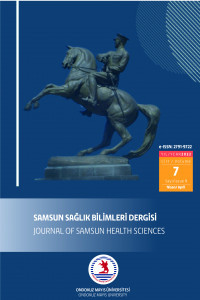VİRAL ENFEKSİYON İLE ENFEKTE OLAN GEBE KADINLARIN DENEYİMLERİ: NİTEL ARAŞTIRMA
EXPERIENCES OF PREGNANT WOMEN INFECTED WITH VIRAL INFECTION: QUALITATIVE RESEARCH
Pregnancy, Hepatitis B, Hepatitis C, HIV,
___
- Adjei, C. A., Stutterheim, S. E., Naab, F., & Ruiter, R. A. (2019). Chronic Hepatitis B stigma in Ghana: a qualitative study with patients and providers. BMJ Open, 9(6), e025503.
- Ahad, M., Wallace, J., Xiao, Y., van Gemert, C., Bennett, G., Darby, J., et. al. (2022). Hepatitis B and pregnancy: understanding the experiences of care among pregnant women and recent mothers in metropolitan Melbourne. BMC Public Health, 22(1), 1-8.
- Belopolskaya, M., Avrutin, V., Kalinina, O., Dmitriev, A., & Gusev, D. (2021). Chronic hepatitis B in pregnant women: Current trends and approaches. World Journal of Gastroenterology, 27(23), 3279–3289.
- Buregyeya, E., Naigino, R., Mukose, A., Makumbi, F., Esiru, G., Arinaitwe, J., et. al. (2017). Facilitators and barriers to uptake and adherence to lifelong antiretroviral therapy among HIV infected pregnant women in Uganda: a qualitative study. BMC Pregnancy and Childbirth, 17(1), 1-9.
- Creswell, J. W. (2014) Research Design: Qualitative, Quantitative, and Mixed Methods Approaches. USA: Sage Publications.
- Ferguson, L., Lewis, J., Grant, A. D., Watson-Jones, D., Vusha, S., Ong’ech, J. O., & Ross, D. A. (2012). Patient attrition between diagnosis with HIV in pregnancy-related services and long-term HIV care and treatment services in Kenya: a retrospective study. JAID, 60(3), 90-97.
- Fletcher, F., Ingram, L. A., Kerr, J., Buchberg, M., Richter, D. L., & Sowell, R. (2016). “Out of all of this mess, I got a blessing”: Perceptions and experiences of reproduction and motherhood in African American women living with HIV. J Assoc Nurses AIDS Care, 27(4), 381-391.
- Giles, M. L., Grace, R., Tai, A., Michalak, K., & Walker, S. P. (2013). Prevention of mother‐to‐child transmission of hepatitis B virus (HBV) during pregnancy and the puerperium: current standards of care. Aust N Z J Obstet Gynaecol, 53(3), 231-235.
- Güngör Satılmış, İ., Mecdi Kaydırak, M., (2019). Gebelikte Enfeksiyon Hastalıkları ve Bakım. Sermin Timur Taşhan, Özlem Doğan Yüksekol, Mesude (Ed.), Riskli Gebelikler ve Bakım içinde (ss 313-352). Ankara: Göktuğ Basın ve Yayın Dağıtım ve Pazarlama.
- Kelly, C., Alderdice, F., Lohan, M., & Spence, D. (2012). Creating continuity out of the disruption of a diagnosis of HIV during pregnancy. J Clin Nurs, 21(11‐12), 1554-1562.
- Kislovskiy, Y., Chappell, C., Flaherty, E., Hamm, M. E., Cameron, F. D. A., Krans, E. E., & Chang, J. C. (2021). Experiences and Perspectives from women taking ınvestigational therapy for hepatitis c virus during pregnancy. Substance Abuse, 15, 1–7.
- Knettel, B. A., Minja, L., Chumba, L. N., Oshosen, M., Cichowitz, C., Mmbaga, B. T., & Watt, M. H. (2019). Serostatus disclosure among a cohort of HIV-infected pregnant women enrolled in HIV care in Moshi, Tanzania: a mixed-methods study. SSM Popul Health, 7, 100323.
- Kushner, T., & Reau, N. (2021). Changing epidemiology, implications, and recommendations for hepatitis C in women of childbearing age and during pregnancy. J Hepatol, 74(3), 734-741.
- Osborn, L., Ronen, K., Larsen, A. M., Richardson, B., Khasimwa, B., Chohan, B., et. al. (2022). Antenatal depressive symptoms in Kenyan women living with HIV: contributions of recent HIV diagnosis, stigma, and partner violence. AIDS Care, 34(1), 69-77.
- Sanhal, C. Y., Ataman, Özel, Ş., & Üstün, Y. E. (2018). Gebelikte HIV enfeksiyonu. Jinekoloji-Obstetrik ve Neonatoloji Tıp Dergisi, 15(2), 87-89. Silasi, M., Cardenas, I., Kwon, J. Y., Racicot, K., Aldo, P., & Mor, G. (2015). Viral infections during pregnancy. Am J Reprod Immunol, 73(3), 199-213.
- Taheri Ezbarami, Z., Hassani, P., Zagheri Tafreshi, M., & Alavi Majd, H. (2017). A qualitative study on individual experiences of chronic hepatitis B patients. Nursing Open, 4(4), 310-318.
- United Nations Programme on HIV/AIDS (UNAIDS). UNAIDS data 2021. Retrieved from. https://www.unaids.org/ sites/default/files/media_asset/JC3032_AIDS_Data_book_2021_En.pdf.
- Valizadeh, L., Zamanzadeh, V., Zabihi, A., Negarandeh, R., & Jafarian Amiri, S. R. (2019). Qualitative study on the experiences of hepatitis B carriers in coping with the disease. Jpn J Nurs Sci, 16(2), 194-201.
- Yayın Aralığı: Yılda 3 Sayı
- Başlangıç: 2021
- Yayıncı: Ondokuz Mayıs Üniversitesi
Yaşlı Cerrahi Hastaları ve Kırılganlık Sendromu
ÜRODİNAMİ KAYNAKLI AĞRI VE ANKSİYETENİN KONTROLÜNDE AROMATERAPİNİN ETKİSİ
Elife KETTAŞ DÖLEK, Gülay ALTUN UĞRAŞ
VİRAL ENFEKSİYON İLE ENFEKTE OLAN GEBE KADINLARIN DENEYİMLERİ: NİTEL ARAŞTIRMA
Fatma ASLAN DEMİRTAŞ, Meltem MECDİ KAYDIRAK, Ümran OSKAY
Derya ŞİMŞEKLİ BAKIRHAN, Kader ÇİFTÇİ
Cilt Bakımında ve Vücut Banyosunda Kullanılan Klorheksidinin Etkisi: Sistematik Derleme
Nazmiye UĞUR, Meryem Türkan IŞIK
Planlanmamış Gebeliklerin Yaşanma Sıklığı ve Beden İmajına Etkisi
GEBELIĞI SONLANDIRMA KARARI: KADIN VE ERKEK PERSPEKTIFI
Derya KAYA ŞENOL, Semiha AYDIN ÖZKAN, Pınar ÇİÇEKOĞLU ÖZTÜRK, Nevin HOTUN ŞAHİN
HEMŞİRELERİN COVID-19 TANILI HASTALAR İLE ÇALIŞMAYA İLİŞKİN GÖRÜŞLERİ VE YAŞADIKLARI ZORLUKLAR
